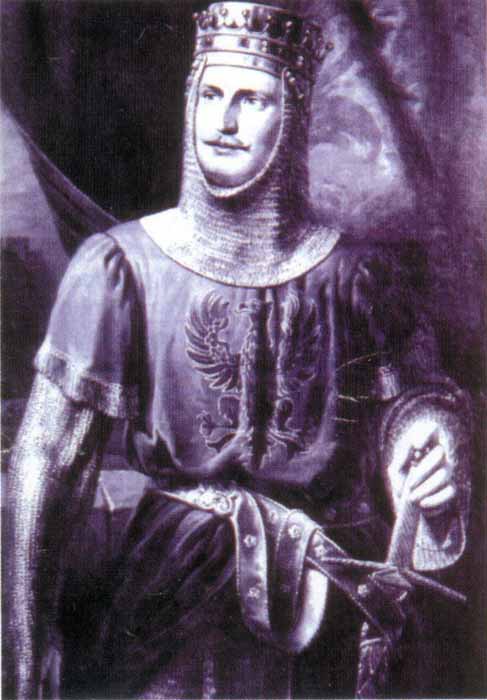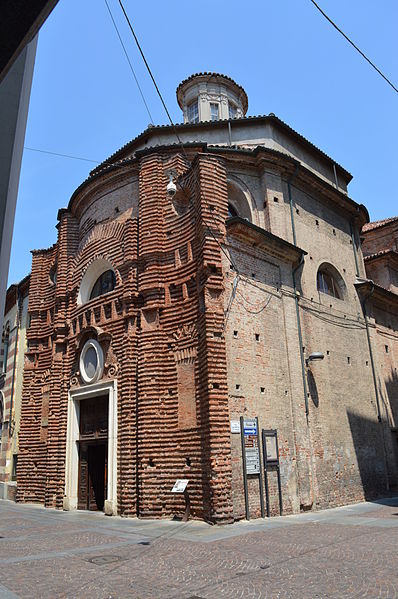Prince Philip dies without meeting his daughter
The fact is that Prince Philip returned to the land of his birth after years of absence. He presented himself first to his uncle, the bishop of Tarantasia, Eduardo of Savoy (1395). After- wards he began to search for his daughter, who was hiding under a pseudonym. The years passed, and neither the wrinkles marking his face, nor his beggar’s clothing betrayed to strangers that he was Philip, the youthful and feared warlord he once was.
 Among the homes he visited in his fruitless search was that of his niece, Blessed Margaret of Savoy-Acaia.12 The last time he was with her, in December 1418, he revealed his true identity, and told her of the miracle at the hour of his execution, and all about his later life. Finally, he entrusted to her his most precious relic— Blessed Umberto’s medal— asking her to give it to his daughter in case she ever appeared.
Among the homes he visited in his fruitless search was that of his niece, Blessed Margaret of Savoy-Acaia.12 The last time he was with her, in December 1418, he revealed his true identity, and told her of the miracle at the hour of his execution, and all about his later life. Finally, he entrusted to her his most precious relic— Blessed Umberto’s medal— asking her to give it to his daughter in case she ever appeared.
According to one of the documents, “Once he had made this last revelation, he breathed his last the next night in the church of Saint Francis, on the sepulcher of his brother Louis of Savoy, even as he yearned to return to the tomb of Blessed Umberto in Altacomba.”13,14
A sacrifice accepted; the preannouncement of Fatima
Blessed Margaret kept the medal. Like her father, Prince Philip’s daughter had disappeared a long time before. In fact, she had joined, “along with her mother, the monastery of Saint Catherine of Alba, taking the name, Sister Filipina, for her father whom she believed to be dead.”15
Years later, Blessed Margaret went to Alba, where she founded the Monastery of Saint Mary Magdalene. Some time later, Sister Filipina requested to be transferred to the new monastery, having an authorization from Pope Nicholas V, dated January 16, 1448. However, it was not until her death that she confessed to Blessed Margaret that she was her cousin. It was at that moment that Sister Filipina learned through Blessed Margaret of the virtuous death of her father, for whose salvation she had offered her religious life, as well as of his passage through Fatima. Then, enraptured with admiration, she received the miraculous medal.
Sister Filipina spent her whole life not knowing that her sacrifice had been accepted. At her death the admirable meaning of her life was presented to her like a lightening flash. Furthermore Heaven rewarded her with a vision of the future triumph of Our Lady over “a certain monster from the Orient… which would be slain by Our Lady of the Holy Rosary of Fatima if all men had invoked her with great penitence.”16
Providential preservation of the documents
The story does not end there. As aforementioned, in 1454 all those present signed and sealed the documents narrating Sister Filipina’s portentous vision to be kept for posterity.
In 1638, 184 years later, Father Jacinto Baresio, O.P., published a history of the noble family of Savoy at the request of the Duchess of Mantua, Margaret of Savoy-Gonzaga, then regent of Portugal. When he wrote it, Father Baresio analyzed Sister Filipina’s chronicle and figured that the episode of Prince Philip’s execution could stain the reputation of the dynasty. So he simply burned it!
However, as soon as he left, the abbess and the older nuns in the monastery, who had read the original, recreated from memory the document’s text, and each one signed the text as a proof of authenticity on October 7, 1640.
In 1655, a nun who signed only her initials, left another written document, confirming everything said in the previous one, in the terms that follow:
The written memoirs say that in Portugal there is a church in a little town called Fatima, built by an ancestor of our holy foundress Margaret of Savoy, Mafalda, Queen of Portugal and daughter of Amadeus II of Savoy, and that a statue of the Most Holy Virgin will speak about very grave future events, for Satan will wage a terrible war. But he will lose because the Most Holy Virgin Mother of God and of the Most Holy Rosary of Fatima, “more terrible than an army in battle array,” will defeat him forever.
1655 A.D. Saint Dominic,
I confide these pages to thee.
Sister C.R. M.
Short Stories on Honor, Chivalry, and the World of Nobility—no. 800
From Crusade Magazine September/October 2004. Pages 6-9.
Notes:
12. Daughter of Amadeus I of Savoy-Acaia, Lord of Piedmont and brother of Prince Philip, Blessed Margaret of Savoy (1390–1474) married Theodore II Paleologo, Marquis of Monferrato. Widowed at age 28, she founded the cloistered Dominican Convent of Santa Maria Madalena, in Alba. Venerated as a saint, Saint Pius V approved her cult in the monastery in 1566, and Clement X extended it to the whole Dominican order. She was proclaimed blessed on September 1, 1838. Her body was exhumed in December 2001 with the approval of the Congregation of the Saints, and found to be incorrupt with no signs of having been embalmed.
13. Or “Hautecombe,” for the abbey housing the Savoy family crypt.
14. Document 1, supra note 2.
15. Document 3, supra note 2.
16. Document 1, supra note 2.
17. In the original, one sometimes finds 1885, sometimes 1855.
18. Document 3, supra note 2.
19. Cf. “The Hidden Truth About Islamic Fundamentalism,” Catolicismo 611 (November 2001).












